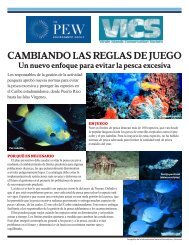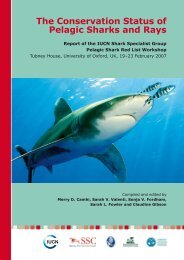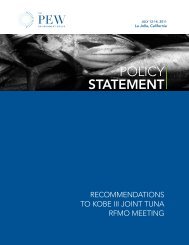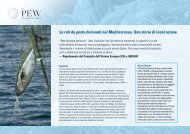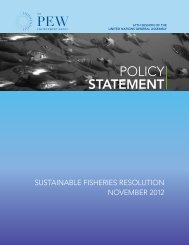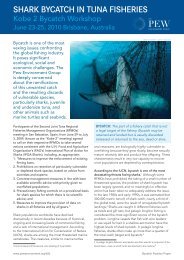Sharks in Trouble - Hunters Become the Hunted
Sharks in Trouble - Hunters Become the Hunted
Sharks in Trouble - Hunters Become the Hunted
Create successful ePaper yourself
Turn your PDF publications into a flip-book with our unique Google optimized e-Paper software.
<strong>Sharks</strong> <strong>in</strong> <strong>Trouble</strong><br />
<strong>Hunters</strong> <strong>Become</strong> <strong>the</strong> <strong>Hunted</strong>
Most shark species are unable to withstand<br />
<strong>the</strong> pressure of modern fish<strong>in</strong>g technology and<br />
practices. 1 Their life history characteristics–<br />
<strong>the</strong>y grow slowly, become sexually mature<br />
relatively late and produce few offspr<strong>in</strong>g–<br />
make <strong>the</strong>m especially vulnerable to<br />
overfish<strong>in</strong>g. Once depleted, shark populations<br />
can take years, decades or more to recover. 2 3<br />
Some fisheries that collapsed <strong>in</strong> <strong>the</strong> first half<br />
of last century have yet to recover. 4 5<br />
This report provides an overview of <strong>the</strong><br />
status of sharks globally, <strong>in</strong>clud<strong>in</strong>g:<br />
Norbert Wu / M<strong>in</strong>den Pictures / FLPA
Overview<br />
• Commercial fisheries target<strong>in</strong>g<br />
sharks exist throughout <strong>the</strong> world.<br />
<strong>Sharks</strong> are sought primarily for <strong>the</strong>ir<br />
f<strong>in</strong>s (for shark f<strong>in</strong> soup) and <strong>the</strong>ir<br />
meat but also for <strong>the</strong>ir cartilage,<br />
liver and sk<strong>in</strong>.<br />
• Up to 73 million sharks are killed<br />
every year, accord<strong>in</strong>g to an analysis<br />
of <strong>the</strong> Hong Kong shark f<strong>in</strong> trade.<br />
The demand for shark f<strong>in</strong>s, meat and<br />
o<strong>the</strong>r products has drive numerous<br />
shark populations to <strong>the</strong> br<strong>in</strong>k of<br />
ext<strong>in</strong>ction.<br />
• Shark populations have<br />
decl<strong>in</strong>ed by as much as 70 to<br />
80 percent, accord<strong>in</strong>g to global<br />
reports. Some populations, such<br />
as <strong>the</strong> porbeagle shark <strong>in</strong> <strong>the</strong> north<br />
western Atlantic and sp<strong>in</strong>y dogfish<br />
<strong>in</strong> <strong>the</strong> nor<strong>the</strong>astern Atlantic, have<br />
been reduced by up to 90 percent.<br />
• Thirty percent of all shark and ray<br />
species are now Threatened or<br />
Near Threatened with ext<strong>in</strong>ction,<br />
and accurate scientific assessments<br />
cannot be done on an additional 47<br />
percent of <strong>the</strong> species because of a<br />
lack of data.<br />
• The highest numbers of reported<br />
shark land<strong>in</strong>gs are from:<br />
Indonesia; India; Taiwan, Prov<strong>in</strong>ce<br />
of Ch<strong>in</strong>a; Spa<strong>in</strong>; and Mexico.<br />
• The catch<strong>in</strong>g of sharks <strong>in</strong> fisheries<br />
that target o<strong>the</strong>r species (bycatch)<br />
is frequently reported <strong>in</strong> open-sea<br />
longl<strong>in</strong>e fisheries target<strong>in</strong>g tuna and<br />
swordfish and can represent as<br />
much as 25 percent of <strong>the</strong> total<br />
catch. This bycatch is considered<br />
to be a major source of mortality for<br />
many shark species worldwide.<br />
• Blue sharks make up a particularly<br />
•<br />
large proportion of shark bycatch<br />
<strong>in</strong> open-sea fisheries (47 to<br />
92 percent).<br />
• The value of shark f<strong>in</strong>s has<br />
•<br />
<strong>in</strong>creased with economic growth<br />
<strong>in</strong> Asia (particularly Ch<strong>in</strong>a), and this<br />
<strong>in</strong>creased value is a major factor<br />
<strong>in</strong> <strong>the</strong> commercial exploitation of<br />
sharks worldwide. One bowl of<br />
shark f<strong>in</strong> soup can cost US$100.<br />
• <strong>Sharks</strong> play an important role <strong>in</strong><br />
•<br />
ma<strong>in</strong>ta<strong>in</strong><strong>in</strong>g <strong>the</strong> structure and<br />
function of <strong>the</strong> ecosystem. They<br />
regulate <strong>the</strong> variety and abundance<br />
of <strong>the</strong> species below <strong>the</strong>m <strong>in</strong> <strong>the</strong><br />
food cha<strong>in</strong>. Impacts from <strong>the</strong> loss<br />
of sharks can be felt throughout <strong>the</strong><br />
entire mar<strong>in</strong>e environment.<br />
• Live sharks have a significant<br />
•<br />
value for mar<strong>in</strong>e ecotourism (such<br />
as recreational div<strong>in</strong>g, snorkell<strong>in</strong>g,<br />
and shark watch<strong>in</strong>g) that is more<br />
susta<strong>in</strong>able and often far more<br />
valuable than <strong>the</strong>ir worth to<br />
fisheries. Whale shark tourism, for<br />
example, is estimated to be worth<br />
$47.5 million annually worldwide,<br />
and shark tourism activities <strong>in</strong> <strong>the</strong><br />
Bahamas generate $78 million<br />
annually for <strong>the</strong> Bahamian economy.<br />
• To reverse decl<strong>in</strong>es <strong>in</strong> shark<br />
•<br />
populations, shark sanctuaries<br />
should be established, and strong,<br />
science-based management should<br />
be put <strong>in</strong> place by all fish<strong>in</strong>g<br />
countries and <strong>in</strong>ternational bodies<br />
that regulate shark fish<strong>in</strong>g and trade.
ONNE VAN DER VAL / BLUEGREENPICTURES.COM<br />
C/O STUART Cove’s DIVE BAHAMAS<br />
GEORGETTE DOUWMA/GETTY IMAGE<br />
<strong>Sharks</strong> are targeted and caught as bycatch<br />
throughout <strong>the</strong> world’s oceans and <strong>in</strong> fisheries that<br />
use surface, mid-water and bottom longl<strong>in</strong>es, drift<br />
and set gill nets, and trawls. 6 7 8 <strong>Sharks</strong> are<br />
targeted primarily for <strong>the</strong>ir f<strong>in</strong>s and meat but<br />
also for cartilage and oils. 9 A study used statistics<br />
based on data from <strong>the</strong> Hong Kong f<strong>in</strong> trade to<br />
estimate that up to 73 million sharks are killed<br />
by humans each year. 10 Ecosystem models and<br />
some field studies suggest that <strong>the</strong> loss of <strong>the</strong>se top<br />
predators could have significant impacts on many<br />
11 12 13<br />
mar<strong>in</strong>e ecosystems.<br />
This document summarizes <strong>the</strong> threats to sharks,<br />
focus<strong>in</strong>g on <strong>the</strong> number of sharks killed per year,<br />
<strong>the</strong> drivers of this mortality, <strong>the</strong> status of shark<br />
species worldwide and <strong>the</strong> impact on ecosystems<br />
when large predators are removed. It also<br />
provides management recommendations that<br />
can help reverse <strong>the</strong> steep decl<strong>in</strong>es of many shark<br />
populations and beg<strong>in</strong> rebuild<strong>in</strong>g <strong>the</strong>m.
Contents<br />
How many sharks are killed each year?<br />
What is <strong>the</strong> result of <strong>in</strong>tense fish<strong>in</strong>g pressure on sharks?<br />
What are <strong>the</strong> most significant causes of shark mortality?<br />
What are <strong>the</strong> driv<strong>in</strong>g forces beh<strong>in</strong>d shark fish<strong>in</strong>g?<br />
What happens to our oceans when top predators are lost?<br />
What is <strong>the</strong> value of a live shark?<br />
How many sharks are killed each year?<br />
What is <strong>the</strong> result of <strong>in</strong>tense fish<strong>in</strong>g<br />
pressure on sharks?<br />
What are <strong>the</strong> most significant causes of<br />
shark mortality?<br />
What are <strong>the</strong> driv<strong>in</strong>g forces beh<strong>in</strong>d<br />
shark fish<strong>in</strong>g?<br />
What happens to our oceans when top<br />
predators are lost?<br />
What is <strong>the</strong> value of a live shark?
How many sharks are<br />
killed each year?<br />
A study of <strong>the</strong> Hong Kong shark f<strong>in</strong> market<br />
found that humans kill 26 to 73 million sharks<br />
each year. 14 This is <strong>the</strong> only comprehensive<br />
estimate of worldwide shark catches, and it is<br />
three to four times higher than <strong>the</strong> estimate<br />
of <strong>the</strong> UN Food and Agriculture Organization<br />
(FAO). 15 The disparity is probably due to <strong>the</strong><br />
fact that <strong>the</strong> FAO records only shark land<strong>in</strong>gs<br />
and has no data related to shark catches<br />
that are unrecorded, recorded <strong>in</strong> non-shark<br />
categories, or discarded at sea. 16<br />
Fur<strong>the</strong>r, <strong>the</strong> estimate on global shark catches<br />
from <strong>the</strong> f<strong>in</strong> market study may be low because<br />
land<strong>in</strong>gs, particularly <strong>in</strong> Asia (e.g., Japan<br />
and Taiwan, Prov<strong>in</strong>ce of Ch<strong>in</strong>a), and discards<br />
of whole sharks at sea may not have been<br />
accounted for. 17
How many sharks are killed each year?<br />
73M<br />
The study of <strong>the</strong> Hong Kong shark f<strong>in</strong><br />
market found that humans kill up to<br />
73 million sharks each year.<br />
SHAWN HEINRICHS
What is <strong>the</strong> result of <strong>in</strong>tense fish<strong>in</strong>g<br />
pressure on sharks?<br />
30 %<br />
The International Union for Conservation of<br />
Nature (IUCN) Red List assessed 1,045 species<br />
of sharks and rays and found that 30 percent of<br />
<strong>the</strong> species are Threatened or Near Threatened<br />
with ext<strong>in</strong>ction.
What is <strong>the</strong> result of <strong>in</strong>tense fish<strong>in</strong>g pressure on sharks?<br />
AMOS NACHOUM / CORBIS
What is <strong>the</strong> result of <strong>in</strong>tense fish<strong>in</strong>g<br />
pressure on sharks?<br />
JIM ABERNETHY<br />
Recent research has documented<br />
dramatic decl<strong>in</strong>es <strong>in</strong> population sizes<br />
for many species of sharks worldwide.<br />
<strong>Sharks</strong> are susceptible to overfish<strong>in</strong>g<br />
because of <strong>the</strong>ir life history characteristics,<br />
which <strong>in</strong>clude slow growth, late maturation<br />
and few offspr<strong>in</strong>g. 18 19 The International<br />
Union for Conservation of Nature (IUCN)<br />
Red List assessed 1,045 species of sharks<br />
and rays and found that 30 percent of<br />
<strong>the</strong> species are Threatened or Near<br />
Threatened with ext<strong>in</strong>ction. 20 Their<br />
f<strong>in</strong>d<strong>in</strong>gs are as follows:<br />
Category<br />
Vulnerable<br />
Endangered<br />
Critically Endangered<br />
Total Threatened<br />
Category<br />
Near Threatened<br />
Least Concern<br />
Data Deficient<br />
Percentage of<br />
Assessed Species<br />
11<br />
4<br />
2<br />
17<br />
Percentage of<br />
Assessed Species<br />
13<br />
23<br />
47<br />
It is important to note that <strong>the</strong> IUCN has<br />
categorized nearly half (47 percent) of all<br />
globally assessed sharks and rays as “data<br />
deficient” because available <strong>in</strong>formation<br />
is <strong>in</strong>sufficient to accurately assess <strong>the</strong>ir<br />
ext<strong>in</strong>ction risk. The status of <strong>in</strong>dividual<br />
shark species is often difficult to determ<strong>in</strong>e<br />
because of a shortage of long-term data<br />
on fish<strong>in</strong>g effort and species-specific<br />
catches, land<strong>in</strong>gs and discards <strong>in</strong><br />
commercial fisheries. 21 22 23 24 The fact that<br />
so many species are classified as data<br />
deficient highlights <strong>the</strong> urgent need for<br />
countries to ga<strong>the</strong>r accurate, speciesspecific<br />
data so that assessments can<br />
be made.<br />
As a Data Deficient list<strong>in</strong>g simply <strong>in</strong>dicates<br />
a lack of data, it does not mean that a<br />
species is not at risk of ext<strong>in</strong>ction. Indeed,<br />
unless fisheries management improves<br />
immediately and dramatically, enhanced<br />
knowledge of Data Deficient species will<br />
undoubtedly f<strong>in</strong>d even more sharks and<br />
rays qualify<strong>in</strong>g for Threatened<br />
25 26<br />
classification.<br />
Dulvy et al. used <strong>the</strong> IUCN Red List<br />
Categories and Criteria to determ<strong>in</strong>e <strong>the</strong><br />
status of 21 pelagic (open ocean) shark<br />
and ray species commonly caught <strong>in</strong> high<br />
seas fisheries. 27 Sixteen of <strong>the</strong> 21 species<br />
were considered globally Threatened or<br />
Near Threatened with ext<strong>in</strong>ction:<br />
Threatened:<br />
• Whale shark (Rh<strong>in</strong>codon typus)<br />
• Pelagic thresher shark<br />
(Alopias pelagicus)<br />
• Bigeye thresher shark<br />
(Alopias superciliosus)<br />
• Thresher shark (Alopias vulp<strong>in</strong>us)<br />
• Bask<strong>in</strong>g shark (Cetorh<strong>in</strong>us maximus)<br />
• Great white shark<br />
(Carcharodon carcharias)<br />
• Shortf<strong>in</strong> mako shark (Isurus oxyr<strong>in</strong>chus)<br />
• Longf<strong>in</strong> mako shark (Isurus paucus)<br />
• Porbeagle shark (Lamna nasus)<br />
• Oceanic whitetip shark<br />
(Carcharh<strong>in</strong>us longimanus)<br />
• Giant devil ray (Mobula mobular)<br />
Near Threatened:<br />
• Blue shark (Prionace glauca)<br />
• Crocodile shark<br />
(Pseudocarcharias kamoharai)<br />
• Silky shark (Carcharh<strong>in</strong>us falciformis)<br />
• Manta ray (Manta birostris)<br />
• Sp<strong>in</strong>etail devil ray (Mobula japanica)
What is <strong>the</strong> result of <strong>in</strong>tense fish<strong>in</strong>g pressure on sharks?<br />
SHAWN HEINRICHS<br />
The best-studied ocean area for shark<br />
populations is <strong>the</strong> northwest Atlantic.<br />
Studies carried out <strong>the</strong>re <strong>in</strong> <strong>the</strong> past few<br />
years have revealed severe decl<strong>in</strong>es <strong>in</strong><br />
many shark species.<br />
Species<br />
Sandbar shark<br />
Dusky shark<br />
Hammerhead shark<br />
(3 species)<br />
Decl<strong>in</strong>e from<br />
Unexploited Levels<br />
64 to 71% 28<br />
80% m<strong>in</strong>imum 29<br />
70% 30<br />
O<strong>the</strong>r studies have <strong>in</strong>dicated decl<strong>in</strong>es as<br />
follows:<br />
• Porbeagle shark populations are<br />
estimated at 10 to 20 percent of<br />
unexploited levels. 31<br />
• North Atlantic shortf<strong>in</strong> mako<br />
populations are at about 50 percent of<br />
unexploited levels. 32<br />
• The nor<strong>the</strong>ast Atlantic sp<strong>in</strong>y dogfish<br />
(Squalus acanthias) population stands<br />
at less than 10 percent of unexploited<br />
levels. 33<br />
• Sandbar shark stocks off Western<br />
Australia are estimated at about 35<br />
percent of unexploited levels. 34<br />
• Oceanic whitetip sharks <strong>in</strong> <strong>the</strong> Gulf of<br />
Mexico have decl<strong>in</strong>ed 99 percent s<strong>in</strong>ce<br />
<strong>the</strong> 1950s. 35
The most significant causes<br />
of shark mortality
45 %<br />
The percentage of all reported shark land<strong>in</strong>gs<br />
<strong>in</strong> 2008 com<strong>in</strong>g from Indonesia; India; Spa<strong>in</strong>;<br />
Argent<strong>in</strong>a; and Taiwan, Prov<strong>in</strong>ce of Ch<strong>in</strong>a.<br />
What are <strong>the</strong> most significant causes of shark mortality?<br />
JEFF ROTMAN / CORBIS
The most significant causes<br />
of shark mortality<br />
Fred Bavendam / M<strong>in</strong>den / FLPA<br />
Commercial shark fish<strong>in</strong>g<br />
Commercial fisheries target<strong>in</strong>g sharks<br />
exist throughout <strong>the</strong> world. <strong>Sharks</strong> are<br />
targeted primarily for <strong>the</strong>ir f<strong>in</strong>s but also<br />
for <strong>the</strong>ir meat, cartilage, liver and sk<strong>in</strong>. 36<br />
Well-documented collapses of directed<br />
shark fisheries (where sharks are <strong>the</strong><br />
primary target) <strong>in</strong>clude:<br />
• sp<strong>in</strong>y dogfish off British Columbia 37<br />
38 39<br />
and <strong>the</strong> North Sea.<br />
• soupf<strong>in</strong> (or school) sharks (Galeorh<strong>in</strong>us<br />
galeus) off Australia 40 and off<br />
California. 41<br />
• porbeagle sharks <strong>in</strong> <strong>the</strong> North Atlantic<br />
42 43<br />
Ocean.<br />
• sandbar and dusky sharks <strong>in</strong> <strong>the</strong><br />
44 45<br />
northwest Atlantic.<br />
The highest numbers of reported shark<br />
land<strong>in</strong>gs are from: Indonesia; India; Spa<strong>in</strong>;<br />
Argent<strong>in</strong>a; and Taiwan, Prov<strong>in</strong>ce of Ch<strong>in</strong>a.<br />
They accounted for 45% of reported shark<br />
land<strong>in</strong>gs <strong>in</strong> 2008. 46<br />
Shark bycatch fisheries<br />
Bycatch is <strong>the</strong> part of <strong>the</strong> catch that is not<br />
targeted – <strong>the</strong> collateral damage caught<br />
along with <strong>the</strong> targeted fish species.<br />
In essence, it is unregulated and often<br />
unreported and is considered to be a<br />
major source of mortality for many shark<br />
species worldwide. 47 48 Although some<br />
sharks caught as bycatch may be reta<strong>in</strong>ed<br />
and landed for sale, often <strong>the</strong>y are thrown<br />
overboard ei<strong>the</strong>r dead or seriously <strong>in</strong>jured.<br />
Bycatch of sharks is particularly<br />
problematic because sharks usually<br />
have slower growth rates than <strong>the</strong> target<br />
fish species. Shark populations can be<br />
seriously depleted through bycatch from<br />
a fishery that may be susta<strong>in</strong>able for<br />
<strong>the</strong> target species but not for sharks. 49<br />
In pelagic longl<strong>in</strong>e fisheries, sharks can<br />
make up more than a quarter of <strong>the</strong> total<br />
catch (and <strong>the</strong>refore constitute more of an<br />
unregulated/unmanaged fishery, than<br />
true bycatch).<br />
Directed shark fisheries are typically<br />
characterized by a “boom and bust”<br />
pattern, <strong>in</strong> which high <strong>in</strong>itial catches are<br />
followed by a rapid crash and usually<br />
result <strong>in</strong> <strong>the</strong> fishery be<strong>in</strong>g closed.<br />
Although some target shark fisheries are<br />
well documented, <strong>the</strong>re are many o<strong>the</strong>rs<br />
worldwide about which little is known.<br />
Unfortunately, many of <strong>the</strong>se fisheries<br />
operate <strong>in</strong> <strong>the</strong> Indo-Pacific, where shark<br />
biodiversity and endemism are high, which<br />
means that many obscure, range-restricted<br />
sharks may be <strong>in</strong> danger of biological<br />
ext<strong>in</strong>ction.
What are <strong>the</strong> most significant causes of shark mortality?<br />
Nancy Boucha / MARINE PHOTOBANK<br />
<strong>Sharks</strong> Caught as Bycatch<br />
Where<br />
U.S. pelagic longl<strong>in</strong>e tuna/swordfish fishery<br />
South African longl<strong>in</strong>e fishery<br />
Australian longl<strong>in</strong>e tuna/billfish fishery<br />
Fiji longl<strong>in</strong>e tuna fishery<br />
Portuguese semi-pelagic longl<strong>in</strong>e fishery<br />
When<br />
1992-2003<br />
1998-2005<br />
1999<br />
1999<br />
1997-1998<br />
Percentage of<br />
total catch<br />
25% i<br />
16% ii<br />
25% ii<br />
25%+ ii<br />
33% iii<br />
i - Abercrombie, D.L., H.A. Balchowsky and A.L. Pa<strong>in</strong>e. 2005. 2002 and 2003 Annual Summary: Large Pelagic<br />
Species. NOAA Technical Memorandum NMFS SEFSC-529.<br />
ii - Gilman, E., S. Clarke, N. Bro<strong>the</strong>rs, J. Alfaro-Shigueto, J. Mandelmann, J. Mangel, S. Peterson, S. Piovano,<br />
N. Thompson, P. Dalzell, M. Donoso, M. Goren and T. Wernder. 2008. “Shark <strong>in</strong>teractions <strong>in</strong> pelagic<br />
longl<strong>in</strong>e fisheries.” Mar<strong>in</strong>e Policy 32:1-18.<br />
iii - Coelho, R., K. Erz<strong>in</strong>i, L. Bentes, C. Correia, P.G. L<strong>in</strong>o, P. Monteiro, J. Ribeiro and J.M.S. Goncalves. 2005.<br />
“Semi-pelagic longl<strong>in</strong>e and trammel net elasmobranch catches <strong>in</strong> sou<strong>the</strong>rn Portugal: catch composition,<br />
catch rates and discards.” Journal of Northwest Atlantic Fishery Science 35:531-537.
What are <strong>the</strong> driv<strong>in</strong>g forces<br />
beh<strong>in</strong>d shark fish<strong>in</strong>g?
What are <strong>the</strong> driv<strong>in</strong>g forces beh<strong>in</strong>d shark fish<strong>in</strong>g?<br />
kg<br />
Shark f<strong>in</strong>s are considered one of <strong>the</strong> most<br />
valuable food items <strong>in</strong> <strong>the</strong> world, reach<strong>in</strong>g<br />
prices as high as US$700 per kg.<br />
Fred Bavendam / M<strong>in</strong>den Pictures / FLPA
What are <strong>the</strong> driv<strong>in</strong>g forces<br />
beh<strong>in</strong>d shark fish<strong>in</strong>g?<br />
JEFF ROTMAN<br />
The IUCN advises that<br />
sharks be landed with <strong>the</strong>ir<br />
f<strong>in</strong>s attached to prevent <strong>the</strong><br />
excessive mortality and waste<br />
associated with f<strong>in</strong>n<strong>in</strong>g.<br />
F<strong>in</strong>s<br />
The value of shark f<strong>in</strong>s has escalated <strong>in</strong><br />
recent years with economic growth <strong>in</strong><br />
Ch<strong>in</strong>a and is a major factor <strong>in</strong> <strong>the</strong><br />
commercial exploitation of sharks<br />
worldwide. 50 51 The shark f<strong>in</strong> trade is<br />
driven by economic, traditional and<br />
cultural factors. 52<br />
From 1985 to 1998, shark f<strong>in</strong> imports to<br />
Hong Kong and Taiwan <strong>in</strong>creased by more<br />
than 214 percent and 42 percent,<br />
respectively. 53 54 In <strong>the</strong> Ch<strong>in</strong>ese market,<br />
trade <strong>in</strong> shark f<strong>in</strong>s grew by 6 percent a<br />
year from 1991 to 2000. 55 Shark f<strong>in</strong>s are<br />
considered one of <strong>the</strong> most valuable food<br />
items <strong>in</strong> <strong>the</strong> world, 56 reach<strong>in</strong>g prices as<br />
high as US$700 per kg. 57 The m<strong>in</strong>imum<br />
value of <strong>the</strong> global trade of shark f<strong>in</strong>s has<br />
been estimated at $400 million to $550<br />
million a year. 58<br />
Shark “f<strong>in</strong>n<strong>in</strong>g”—<strong>the</strong> practice of cutt<strong>in</strong>g<br />
off <strong>the</strong> f<strong>in</strong>s at sea and discard<strong>in</strong>g <strong>the</strong> rest<br />
of <strong>the</strong> shark—is a major source of f<strong>in</strong>s for<br />
<strong>the</strong> lucrative <strong>in</strong>ternational shark f<strong>in</strong> trade.<br />
By keep<strong>in</strong>g only <strong>the</strong> f<strong>in</strong>s, a s<strong>in</strong>gle vessel<br />
can kill an extraord<strong>in</strong>ary number of sharks<br />
on a s<strong>in</strong>gle trip. For example, <strong>in</strong> 2002, <strong>the</strong><br />
U.S. vessel K<strong>in</strong>g Diamond II was caught<br />
by <strong>the</strong> U.S. Coast Guard off <strong>the</strong> coast of<br />
Guatemala with 32 tons of f<strong>in</strong>s on board<br />
(estimated to represent 30,000 sharks),<br />
without <strong>the</strong> correspond<strong>in</strong>g carcasses. 59<br />
Shark f<strong>in</strong>n<strong>in</strong>g is outlawed <strong>in</strong> several<br />
countries, <strong>in</strong>clud<strong>in</strong>g <strong>the</strong> United States,<br />
Costa Rica, South Africa, <strong>the</strong> United<br />
K<strong>in</strong>gdom, Oman, Colombia and <strong>the</strong><br />
member states of <strong>the</strong> European Union.<br />
Several regional fishery management<br />
organizations (RFMOs), <strong>in</strong>clud<strong>in</strong>g <strong>the</strong><br />
International Commission for <strong>the</strong><br />
Conservation of Atlantic Tunas (ICCAT),<br />
<strong>the</strong> Inter-American Tropical Tuna<br />
Commission (IATTC), <strong>the</strong> Indian Ocean<br />
Tuna Commission (IOTC) and <strong>the</strong> Western<br />
and Central Pacific Fisheries Commission<br />
(WCPFC), have also prohibited f<strong>in</strong>n<strong>in</strong>g.<br />
There are often no clear guidel<strong>in</strong>es on how<br />
<strong>the</strong> bans are to be enforced, however, and<br />
60 61<br />
loopholes rema<strong>in</strong>.
What are <strong>the</strong> driv<strong>in</strong>g forces beh<strong>in</strong>d shark fish<strong>in</strong>g?<br />
CRAM WORLD<br />
Where shark f<strong>in</strong>n<strong>in</strong>g regulations exist,<br />
<strong>the</strong> f<strong>in</strong>-to-carcass ratio is <strong>the</strong> most widely<br />
adopted management measure, but it is<br />
not effective with respect to enforcement.<br />
This ratio is <strong>in</strong>tended to prevent f<strong>in</strong>n<strong>in</strong>g by<br />
ensur<strong>in</strong>g that <strong>the</strong> f<strong>in</strong>s landed are<br />
proportional to <strong>the</strong> bodies landed. The<br />
shark f<strong>in</strong>s reta<strong>in</strong>ed usually cannot exceed<br />
5 percent of <strong>the</strong> weight of <strong>the</strong> sharks<br />
onboard. This ratio has several problems:<br />
It is highly <strong>in</strong>consistent, as it varies with<br />
species, <strong>the</strong> choices of f<strong>in</strong>s, f<strong>in</strong>n<strong>in</strong>g<br />
procedure, <strong>the</strong> state of <strong>the</strong> shark carcass<br />
and even <strong>the</strong> degree to which <strong>the</strong> f<strong>in</strong>s are<br />
dried. 62 Fur<strong>the</strong>r, <strong>the</strong> ratio system allows<br />
high grad<strong>in</strong>g, <strong>in</strong> which fish<strong>in</strong>g vessels can<br />
br<strong>in</strong>g mismatched f<strong>in</strong>s and carcasses to<br />
port, keep<strong>in</strong>g carcasses from sharks valued<br />
for <strong>the</strong>ir meat and <strong>the</strong> non-match<strong>in</strong>g f<strong>in</strong>s<br />
from sharks with highly valuable f<strong>in</strong>s but<br />
low-quality meat.<br />
<strong>Sharks</strong> should be landed with <strong>the</strong>ir<br />
f<strong>in</strong>s attached to prevent <strong>the</strong> excessive<br />
mortality and waste associated with<br />
f<strong>in</strong>n<strong>in</strong>g. Fur<strong>the</strong>r, a 2006 scientific paper on<br />
f<strong>in</strong> ratios prepared for <strong>the</strong> ICCAT stated<br />
that “<strong>the</strong> only guaranteed method to<br />
avoid shark f<strong>in</strong>n<strong>in</strong>g is to land sharks with<br />
all f<strong>in</strong>s attached.” 63 Indeed, most shark<br />
experts agree that this straightforward<br />
approach is <strong>the</strong> most reliable means to<br />
implement a f<strong>in</strong>n<strong>in</strong>g ban.<br />
Meat<br />
Shark meat is more difficult to process<br />
than meat from most fish species because<br />
of its high urea content, 64 which also<br />
makes it less marketable <strong>in</strong> many areas<br />
and has led to many species of sharks<br />
be<strong>in</strong>g targeted for <strong>the</strong>ir f<strong>in</strong>s alone. Shark<br />
meat is less economically valuable than<br />
shark f<strong>in</strong>s, or meat from o<strong>the</strong>r more widely<br />
eaten fish species, such as tuna and<br />
swordfish. 65 For example, U.S. exports of<br />
shark f<strong>in</strong>s <strong>in</strong> 2006 had a value of US$93.68<br />
per kilogram; by contrast, fresh and frozen<br />
shark meat was worth $2.09 and $1.94<br />
per kg, respectively. 66<br />
However, shortf<strong>in</strong> mako, thresher<br />
and porbeagle sharks are considered<br />
high-value species for meat <strong>in</strong> <strong>the</strong><br />
European and U.S. seafood markets<br />
and for sashimi <strong>in</strong> Asia. 67 Many smaller<br />
species, such as <strong>the</strong> sp<strong>in</strong>y dogfish, are<br />
68 69<br />
also commonly used for food.<br />
Some shark species, such as blue and<br />
hammerhead sharks, are targeted<br />
specifically for <strong>the</strong>ir f<strong>in</strong>s because of<br />
a perceived difficulty <strong>in</strong> process<strong>in</strong>g<br />
<strong>the</strong>ir meat. 70
What happens to our oceans when<br />
top predators are lost?<br />
The decl<strong>in</strong>e <strong>in</strong> shark populations<br />
can lead to unpredictable<br />
consequences, <strong>in</strong>clud<strong>in</strong>g <strong>the</strong><br />
collapse of important fisheries.
What happens to our oceans when top predators are lost?<br />
JIM ABERNETHY
JEFF ROTMAN<br />
What happens to our oceans when<br />
top predators are lost?
What happens to our oceans when top predators are lost?<br />
GEORGETTE DOUWMA / GETTY IMAGES<br />
As top predators, sharks play an<br />
important role <strong>in</strong> ma<strong>in</strong>ta<strong>in</strong><strong>in</strong>g <strong>the</strong><br />
structure and function of <strong>the</strong> mar<strong>in</strong>e<br />
ecosystem. 71 72 The loss of sharks can<br />
cause dramatic shifts <strong>in</strong> <strong>the</strong> mar<strong>in</strong>e<br />
environment, <strong>in</strong>clud<strong>in</strong>g a cascade of<br />
<strong>in</strong>direct effects result<strong>in</strong>g from changes <strong>in</strong><br />
73 74 75 76<br />
<strong>the</strong> abundance of o<strong>the</strong>r organisms.<br />
Without sharks to regulate <strong>the</strong> abundance<br />
of species below <strong>the</strong>m, shifts <strong>in</strong> population<br />
sizes can cascade throughout <strong>the</strong> food<br />
cha<strong>in</strong> and disrupt <strong>the</strong> balance of <strong>the</strong><br />
ecosystem.<br />
The decl<strong>in</strong>e <strong>in</strong> shark populations can<br />
lead to unpredictable consequences,<br />
<strong>in</strong>clud<strong>in</strong>g <strong>the</strong> collapse of important<br />
fisheries. In <strong>the</strong> northwest Atlantic, for<br />
example, populations of sharks have<br />
dropped to <strong>the</strong> po<strong>in</strong>t that <strong>the</strong>y may no<br />
longer fulfil <strong>the</strong>ir role as a top predator <strong>in</strong><br />
<strong>the</strong> ecosystem. 77 Off <strong>the</strong> coast of North<br />
Carol<strong>in</strong>a, scientists believe that <strong>the</strong><br />
cownose ray population exploded due<br />
to <strong>the</strong> loss of large sharks, which helped<br />
keep <strong>the</strong> ecosystem <strong>in</strong> balance and <strong>the</strong>ir<br />
prey <strong>in</strong> check. With more cownose rays,<br />
which eat scallops, clams and oysters,<br />
<strong>the</strong> bay scallop population collapsed and<br />
was term<strong>in</strong>ated. 78 With <strong>the</strong> loss of <strong>the</strong> bay<br />
scallops, <strong>the</strong> clams and oysters along <strong>the</strong><br />
eastern coast of <strong>the</strong> United States may<br />
experience a similar fate. 79 A model of <strong>the</strong><br />
French Frigate Shoals ecosystem <strong>in</strong> Hawaii<br />
found that <strong>the</strong> removal of tiger sharks<br />
presented a similar scenario. Without<br />
<strong>the</strong> tiger sharks to keep <strong>the</strong> seabird<br />
population <strong>in</strong> check, <strong>in</strong>creased seabird<br />
predation on tuna and jacks caused a<br />
significant decl<strong>in</strong>e <strong>in</strong> <strong>the</strong> populations of<br />
<strong>the</strong>se important commercial fish species. 80<br />
Impacts from <strong>the</strong> loss of sharks can be<br />
felt throughout <strong>the</strong> entire system. In coral<br />
reef ecosystems, such as those <strong>in</strong> <strong>the</strong><br />
Caribbean and Pacific, corals depend on<br />
herbivorous fish such as parrot fish to eat<br />
algae and provide space for corals to<br />
settle and grow. 81 When sharks are<br />
removed from <strong>the</strong> system, <strong>the</strong> larger fish,<br />
which feed on herbivorous fish, <strong>in</strong>crease <strong>in</strong><br />
abundance. 82 Without <strong>the</strong> smaller fish to<br />
eat <strong>the</strong> algae, corals can no longer<br />
compete for space. As a result, <strong>the</strong><br />
ecosystem switches to an algaedom<strong>in</strong>ated<br />
system, lack<strong>in</strong>g <strong>the</strong> diversity<br />
and abundance of species once found<br />
with<strong>in</strong> <strong>the</strong> coral reef ecosystem. 83<br />
Impacts from <strong>the</strong> loss of<br />
sharks can be felt throughout<br />
<strong>the</strong> entire ecosystem.
What is <strong>the</strong> value of a live shark?
What is <strong>the</strong> value of a live shark?<br />
It has been estimated that whale shark tourism,<br />
ma<strong>in</strong>ly through recreational div<strong>in</strong>g, is worth about<br />
US$47.5 million worldwide.<br />
WOLCOTT HENRY / MARINE PHOTOBANK
What is <strong>the</strong> value of a live shark?<br />
C/O STUART COVE’S DIVE BAHAMAS<br />
Live sharks have a significant value for<br />
mar<strong>in</strong>e ecotourism, such as recreational<br />
div<strong>in</strong>g and shark watch<strong>in</strong>g from boats,<br />
that is typically more susta<strong>in</strong>able and<br />
often more lucrative than shark fish<strong>in</strong>g and<br />
trade. 84 85 Shark ecotourism sites <strong>in</strong>clude<br />
<strong>the</strong> Bahia de los Angeles conservation<br />
area <strong>in</strong> Mexico; 86 87 88 89<br />
<strong>the</strong> Seychelles;<br />
South Africa; 90 <strong>the</strong> Philipp<strong>in</strong>es; 91 Phuket,<br />
Thailand; 92 <strong>the</strong> Maldives; 93 Belize; 94<br />
and N<strong>in</strong>galoo Mar<strong>in</strong>e Park <strong>in</strong> Western<br />
Australia. 95<br />
Indeed, researchers document more<br />
than 200 shark dive tourism operations<br />
around <strong>the</strong> world. 96 Although many shark<br />
species are <strong>the</strong> focus of mar<strong>in</strong>e<br />
ecotourism, 97 large, charismatic species<br />
yield <strong>the</strong> highest revenue. It has been<br />
estimated that whale shark tourism,<br />
ma<strong>in</strong>ly through recreational div<strong>in</strong>g, is<br />
worth about US$47.5 million worldwide. 98<br />
In Australia, <strong>the</strong> value of each liv<strong>in</strong>g<br />
whale shark was estimated at<br />
AU$282,000, 99 and <strong>in</strong> Belize, <strong>the</strong> value<br />
was put at US$2.09 million over a shark’s<br />
lifetime, or $34,906 a year. 100 In <strong>the</strong><br />
Maldives, <strong>in</strong>dividual grey reef sharks were<br />
estimated to have an annual value of<br />
US$33,500 <strong>in</strong> 1993. 101 In 2005, whale shark<br />
ecotourism created 300 jobs, an <strong>in</strong>crease<br />
<strong>in</strong> annual <strong>in</strong>come and an economic<br />
return of about US$623,000 <strong>in</strong> Donsol,<br />
Philipp<strong>in</strong>es. 102 F<strong>in</strong>ally, a 2010 study found<br />
that an <strong>in</strong>dividual reef shark <strong>in</strong> Palau was<br />
estimated to have an annual value of<br />
US$179,000 and a lifetime value of US$1.9<br />
million to <strong>the</strong> tourism <strong>in</strong>dustry. 103<br />
In Australia, <strong>the</strong> value of each liv<strong>in</strong>g<br />
whale shark was estimated at<br />
AU$282,000, and <strong>in</strong> Belize <strong>the</strong> value<br />
was put at US$2.09 million over a<br />
shark’s lifetime, or $34,906 a year.
What is <strong>the</strong> value of a live shark?<br />
JIM ABERNETHY<br />
Shark Tourism Values <strong>in</strong> Selected Locations<br />
Location<br />
Activity<br />
Value<br />
(millions)*<br />
Year<br />
N<strong>in</strong>galoo, Australia<br />
Whale shark tours<br />
US$5.93<br />
2006 a<br />
Seychelles<br />
Whale shark research/tours<br />
US$2.02<br />
Projected annually b<br />
Gansbaai, S. Africa<br />
Shark div<strong>in</strong>g<br />
US$4.4<br />
2000/2001 c<br />
Belize<br />
Whale shark tours<br />
US$3.7<br />
Annually d<br />
Donsol, Philipp<strong>in</strong>es<br />
Whale shark watch<strong>in</strong>g<br />
US$0.62<br />
Annually e<br />
Canary Is., Spa<strong>in</strong><br />
Shark div<strong>in</strong>g<br />
US$24.7<br />
Annually f<br />
Indo-Pacific region<br />
Shark div<strong>in</strong>g<br />
US$40<br />
Annually g<br />
a - Jones, T., D. Wood, J. Catl<strong>in</strong> and B. Norman. 2009. “Expenditure and ecotourism: predictors of expenditure for whale<br />
shark tour participants.” Journal of Ecotourism 8:32-50.<br />
b - Rowat, D. and U. Engelhardt. 2007. “Seychelles: a case study of community <strong>in</strong>volvement <strong>in</strong> <strong>the</strong> development of whale<br />
shark ecotourism and its socio-economic impact.” Fisheries Research 84:109-113.<br />
c - Hara, M., I. Majaraj and L. Pi<strong>the</strong>rs. 2003. Mar<strong>in</strong>e-based Tourism <strong>in</strong> Gansbaai: A Socio-economic Study. Programme for<br />
Land and Agrarian Studies, University of <strong>the</strong> Western Cape, Bellville.<br />
d - Graham, R.T. 2003. Behavior and conservation of whale sharks on <strong>the</strong> Belize Barrier Reef. Dissertation, University of<br />
York.<br />
e - Quiros, A.L. 2005. “Whale shark ‘ecotourism’ <strong>in</strong> <strong>the</strong> Philipp<strong>in</strong>es and Belize: evaluat<strong>in</strong>g conservation and community<br />
benefits.” Tropical Resources Bullet<strong>in</strong> 24:42-48.<br />
f - De la Cruz Mod<strong>in</strong>o, R., Esteban, A., Crilly, R. & Pascual- Fernández, J. (2010). Bucear con tiburones y rayas en España.<br />
Análisis de su potencial en España y de los beneficios económicos de la actividad en las Islas Canarias. Instituto Universitario<br />
de Ciencias Políticas y Sociales de la Universidad de La laguna y nef, 39 pp.<br />
g – Vianna, G., M. Meekan, D. Pannell, S. Marsh, and J. Meeuwig. 2010. Wanted Dead or Alive? The relative value of<br />
reef sharks as a fishery and an ecotourism asset <strong>in</strong> Palau. Australian Institute of Mar<strong>in</strong>e Science and University of Western<br />
Australia, Perth.<br />
*For consistency and ease <strong>in</strong> comparison, non-USD figures were converted to USD <strong>in</strong> October 2010.
Conclusions and recommendations<br />
The exploitation of sharks <strong>in</strong> commercial fisheries for <strong>the</strong>ir<br />
f<strong>in</strong>s, meat, liver oil, cartilage and o<strong>the</strong>r parts rema<strong>in</strong>s largely<br />
unregulated across most of <strong>the</strong> world. Overfish<strong>in</strong>g, excessive<br />
bycatch, a lack of scientific data, poor management, shark<br />
f<strong>in</strong>n<strong>in</strong>g and <strong>the</strong> lack of political will to adopt best practices<br />
have led to decl<strong>in</strong>es <strong>in</strong> populations of many shark species<br />
worldwide. To reverse <strong>the</strong>se decl<strong>in</strong>es, Pew’s Global Shark<br />
Conservation campaign believes concerted action must be<br />
taken by all fish<strong>in</strong>g countries and <strong>in</strong>ternational bodies that<br />
regulate shark fish<strong>in</strong>g and trade, <strong>in</strong>clud<strong>in</strong>g:<br />
Fish<strong>in</strong>g countries should:<br />
• Establish shark sanctuaries with<strong>in</strong> <strong>the</strong>ir<br />
waters, <strong>in</strong>clud<strong>in</strong>g <strong>the</strong>ir full exclusive<br />
economic zones (EEZ), where sharks are<br />
fully protected from exploitation.<br />
• Devise and implement effective National<br />
Plans of Action for sharks.<br />
• End fish<strong>in</strong>g of sharks that are<br />
Threatened or Near Threatened with<br />
ext<strong>in</strong>ction and sharks that do not have<br />
science-based management plans<br />
<strong>in</strong> place.<br />
• Enact legislation prohibit<strong>in</strong>g <strong>the</strong> removal<br />
of shark f<strong>in</strong>s at sea.<br />
• Work to elim<strong>in</strong>ate shark bycatch.<br />
• Enact immediate protections for species<br />
listed by multilateral agreements such<br />
as <strong>the</strong> Convention on Migratory Species<br />
(CMS) and <strong>the</strong> Convention on<br />
International Trade <strong>in</strong> Endangered<br />
Species of Wild Fauna and Flora (CITES).<br />
• Impose precautionary shark catch limits<br />
that are based on sound science.<br />
• Improve species-specific fisheries and<br />
trade data collection.<br />
• Generate high-quality scientific research<br />
on shark fisheries, shark population<br />
status, and national and <strong>in</strong>ternational<br />
trade to <strong>in</strong>form decision mak<strong>in</strong>g that is<br />
precautionary and ecosystem-based.<br />
RFMOs and bodies tasked with<br />
regulat<strong>in</strong>g shark fisheries and<br />
trade should:<br />
• Adopt b<strong>in</strong>d<strong>in</strong>g measures prohibit<strong>in</strong>g <strong>the</strong><br />
fish<strong>in</strong>g and retention of shark species<br />
that do not have science-based fishery<br />
management plans or are listed by <strong>the</strong><br />
IUCN as be<strong>in</strong>g Threatened or Near<br />
Threatened with ext<strong>in</strong>ction.<br />
• Adopt b<strong>in</strong>d<strong>in</strong>g measures that prohibit<br />
<strong>the</strong> removal of shark f<strong>in</strong>s at sea.<br />
• Require <strong>the</strong>ir members to provide<br />
reliable, species-specific data on<br />
land<strong>in</strong>gs and discards and impose<br />
mean<strong>in</strong>gful penalties on those who do<br />
not comply.<br />
• Ensure full <strong>in</strong>dependent observer<br />
coverage of vessels fish<strong>in</strong>g with<strong>in</strong> <strong>the</strong><br />
areas <strong>the</strong>y manage.<br />
• Adopt gear modifications and o<strong>the</strong>r<br />
measures, such as bans on wire leaders,<br />
to ensure that bycatch of sharks is<br />
m<strong>in</strong>imized as much as possible.<br />
AMOS NACHOUM / CORBIS
Conclusions and recommendations
References<br />
1 Camhi, Merry D., et al. (2008). <strong>Sharks</strong> of <strong>the</strong> Open Ocean:<br />
Biology, Fisheries & Conservation, p. 411.<br />
2 Cortés, E., et al. (2006a). Stock assessment of <strong>the</strong> dusky<br />
shark <strong>in</strong> <strong>the</strong> U.S. Atlantic and Gulf of Mexico. Susta<strong>in</strong>able<br />
Fisheries Division Contribution SFD-2006-014. .<br />
3 National Mar<strong>in</strong>e Fisheries Service. (2006). SEDAR 11 Stock<br />
assessment report: large coastal shark complex, blacktip and<br />
sandbar shark. NMFS Office of Susta<strong>in</strong>able Fisheries, Silver<br />
Spr<strong>in</strong>g, Md. .<br />
4 Fowler, S.L., (2005). Bask<strong>in</strong>g Shark. In: S.L. Fowler, R.D.<br />
Cavanagh, M. Camhi, G.H. Burgess, G.M. Cailliet, S.V.<br />
Fordham, C.A. Simpfendorfer and J.A. Musick, (2005). In:<br />
<strong>Sharks</strong>, rays and chimaeras: The status of <strong>the</strong> chondrichthyan<br />
fishes. IUCN SSC Shark Specialist Group. IUCN, Gland,<br />
Switzerland and Cambridge, UK.<br />
5 Campana, S., et al. (2008). The rise and fall (aga<strong>in</strong>) of <strong>the</strong><br />
porbeagle shark population <strong>in</strong> <strong>the</strong> northwest Atlantic. In:<br />
M.D. Camhi, E.K. Pikitch and E.A. Babcock (Eds.), <strong>Sharks</strong><br />
of <strong>the</strong> Open Ocean: Biology, Fisheries and Conservation,<br />
pp. 445-461. Blackwell Publish<strong>in</strong>g, Oxford, England. .<br />
6 Gilman, E., et al. (2008). Shark <strong>in</strong>teractions <strong>in</strong> pelagic longl<strong>in</strong>e<br />
fisheries. Mar<strong>in</strong>e Policy 32:1-18. .<br />
7 Camhi, M.D., et al. (2009). The conservation status of pelagic<br />
sharks and rays: report of <strong>the</strong> IUCN Shark Specialist Group,<br />
Pelagic Shark Red List Workshop. IUCN Species Survival<br />
Commission Shark Specialist Group, Newbury, England.<br />
.<br />
8 Morgan, A., et al. (2009). An overview of <strong>the</strong> United States<br />
East Coast bottom longl<strong>in</strong>e shark-fishery, 1994-2003. Mar<strong>in</strong>e<br />
Fisheries Review 71:23-38. .<br />
9 Vannucc<strong>in</strong>i, S. (1999). Shark utilization, market<strong>in</strong>g and<br />
trade. FAO Fisheries Technical Paper 389. .<br />
10 Clarke, S.C., et al. (2006a). Global estimates of shark catches<br />
us<strong>in</strong>g trade records from commercial markets. Ecology Letters<br />
9:1115-1126. .<br />
11 Stevens, J.D., et al. (2000). The effects of fish<strong>in</strong>g on sharks,<br />
rays, and chimaeras (chondrichthyans), and <strong>the</strong> implications for<br />
mar<strong>in</strong>e ecosystems. ICES Journal of Mar<strong>in</strong>e Science 57:476-<br />
494. .<br />
12 Bascompte, J., C.J. Melián and E. Sala. (2005). Interaction<br />
strength comb<strong>in</strong>ations and <strong>the</strong> overfish<strong>in</strong>g of a mar<strong>in</strong>e food<br />
web. Proceed<strong>in</strong>gs of <strong>the</strong> National Academy of Sciences<br />
102:5443-5447. .<br />
13 Myers, R.A., et al. (2007). Cascad<strong>in</strong>g effects of <strong>the</strong> loss<br />
of apex predatory sharks from a coastal ocean. Science<br />
315:1846- 1850. .<br />
14 Clarke, S.C., et al. (2006a).<br />
15 Ibid.<br />
16 Ibid.<br />
17 Ibid.<br />
18 Cortés, E. (2002). Incorporat<strong>in</strong>g uncerta<strong>in</strong>ty <strong>in</strong>to<br />
demographic model<strong>in</strong>g: Application to shark populations<br />
and <strong>the</strong>ir conservation. Conservation Biology 16:1048-1062.<br />
.<br />
19 Heppell, S.S., L.B. Crowder and T.R. Menzel. (1999). Life<br />
table analysis of long-lived mar<strong>in</strong>e species with implications<br />
for conservation and management. In: J.A. Musick (Ed.),<br />
Life <strong>in</strong> <strong>the</strong> slow lane: ecology and conservation of long-lived<br />
mar<strong>in</strong>e animals, pp. 137-148. American Fisheries Society<br />
Symposium, Be<strong>the</strong>sda, Md. .<br />
20 Camhi, M.D., et al. (2009).<br />
21 Ibid.<br />
22 Stevens, J.D., et al. (2000).<br />
23 Bonfil, R. (2005). Fishery stock assessment models and<br />
<strong>the</strong>ir application to sharks. In: J.A. Musick and R. Bonfil (Eds.),<br />
Management Techniques for Elasmobranch Fisheries, pp. 154-<br />
181. FAO Fisheries Technical Paper 474, Food and Agriculture<br />
Organization of <strong>the</strong> United Nations, Rome. .<br />
24 Anderson, E.D. 1990. Fishery models as applied to<br />
elasmobranch fisheries. In: H.L. Pratt, Jr., S.H. Gruber and T.<br />
Taniuchi (Eds.), Elasmobranchs as Liv<strong>in</strong>g Resources: Advances <strong>in</strong><br />
<strong>the</strong> Biology, Ecology, Systematics, and <strong>the</strong> Status of Fisheries,<br />
pp. 473-484. NOAA Technical Report NMFS 90. .<br />
25 Gibson, C., et al. (2008). The conservation of nor<strong>the</strong>ast<br />
Atlantic chondrichthyans: report of <strong>the</strong> IUCN Shark Specialist<br />
Group Nor<strong>the</strong>ast Atlantic Red List Workshop. IUCN Species<br />
Survival Commission Shark Specialist Group, Newbury,<br />
England. viii + 76 pp. .<br />
26 Camhi, M.D., et al. (2009).<br />
27 Dulvy, N.K. et al. (2008). You can swim but you can’t hide:<br />
<strong>the</strong> global status and conservation of oceanic pelagic sharks<br />
and rays. Aquatic Conservation: Mar<strong>in</strong>e and Freshwater<br />
Ecosystems 18:459-482. .<br />
28 National Mar<strong>in</strong>e Fisheries Service. (2006).<br />
29 Cortés, E., et al. (2006a).<br />
30 Jiao, Y., C. Hayes and E. Cortés. (2009). Hierarchical<br />
Bayesian approach for population dynamics model<strong>in</strong>g of fish<br />
complexes without species-specific data. ICES Journal of<br />
Mar<strong>in</strong>e Science 66:367-387. .<br />
31 Campana, S., et al. (2008).<br />
32 International Commission for <strong>the</strong> Conservation of Atlantic<br />
Tunas (ICCAT). (2008). Report of <strong>the</strong> 2008 shark stock<br />
assessments meet<strong>in</strong>g. SCRS/2008/014. .<br />
33 International Council for <strong>the</strong> Exploration of <strong>the</strong> Sea (ICES).<br />
2006. Report of <strong>the</strong> work<strong>in</strong>g group on elasmobranch fishes<br />
(WGEF). ICES CM 2006/ACFM. .<br />
34 McAuley, R. (2008a). Nor<strong>the</strong>rn shark fisheries status report.<br />
In: W.J. Fletcher and K. Santoro (Eds.), State of <strong>the</strong> Fisheries<br />
Report 2008/09, pp. 172-177. Department of Fisheries, Perth,<br />
Australia. .<br />
35 Baum, J. K. and Myers, R. A. (2004). Shift<strong>in</strong>g basel<strong>in</strong>es and<br />
<strong>the</strong> decl<strong>in</strong>e of pelagic sharks <strong>in</strong> <strong>the</strong> Gulf of Mexico. Ecology<br />
Letters 7:135–145. .<br />
36 Vannucc<strong>in</strong>i, S. (1999).<br />
37 Ketchen, K.S. (1986). The sp<strong>in</strong>y dogfish (Squalus acanthias)<br />
<strong>in</strong> <strong>the</strong> nor<strong>the</strong>ast Pacific and a history of its utilization. Canadian<br />
Special Publication of Fisheries and Aquatic Science 88.<br />
38 Hoff, T.B. and J.A. Musick. (1990). Western North Atlantic<br />
shark fishery management problems and <strong>in</strong>formational<br />
requirements. NOAA Technical Report NMFS 90:455-472.<br />
.<br />
39 Holden, M.J. (1968). The rational exploitation of <strong>the</strong><br />
Scottish-Norwegian stocks of spurdogs (Squalus acanthias L.).<br />
Fisheries Investigation of <strong>the</strong> M<strong>in</strong>istry of Fisheries and Food<br />
U.K. 25:1-28.<br />
40 Olsen, A.M. (1959). The status of <strong>the</strong> school shark fishery<br />
<strong>in</strong> sou<strong>the</strong>astern Australia waters. Australian Journal of Mar<strong>in</strong>e<br />
and Freshwater Research 10:150-176. .<br />
41 Ripley, W.E. (1946). The soup-f<strong>in</strong> shark and <strong>the</strong> fishery.<br />
Fisheries Bullet<strong>in</strong> 64:7-37. .<br />
42 Campana, S., et al. (2008).<br />
43 Campana, S., et al. (2001). Analytical assessment of <strong>the</strong><br />
porbeagle shark (Lamna nasus) population <strong>in</strong> <strong>the</strong> northwest<br />
Atlantic with estimates of long-term susta<strong>in</strong>able yield. Canadian<br />
Science Advisory Secretariat Research Document 2001/067.<br />
.<br />
44 National Mar<strong>in</strong>e Fisheries Service. (2006).<br />
45 Cortés, E., et al. (2006a).<br />
46 Food And Agriculture Organization (FAO) FishStat Capture<br />
Production Data for 2008. .
47 Mandelman, J.W., et al. (2008). Shark bycatch and<br />
depredation <strong>in</strong> <strong>the</strong> U.S. Atlantic pelagic longl<strong>in</strong>e fishery. Review<br />
of Fish Biology and Fisheries 18:427-442. .<br />
48 Gilman, E., et al. (2007). Shark depredation and unwanted<br />
bycatch <strong>in</strong> pelagic longl<strong>in</strong>e fisheries: <strong>in</strong>dustry practices and<br />
attitudes, and shark avoidance strategies. Western Pacific<br />
Regional Fishery Management Council, Honolulu. .<br />
49 Musick, J. A., et al. (2000). Management of sharks and<br />
<strong>the</strong>ir relatives (Elasmobranchii). Fisheries 25(3):9–13. .<br />
50 Clarke, S.C., E.J. Milner-Gulland and T. Bjorndal. (2007).<br />
Social, economic and regulatory drivers of <strong>the</strong> shark f<strong>in</strong> trade.<br />
Mar<strong>in</strong>e Resource Economics 22:305-327. .<br />
51 Clarke, S. (2004a). Shark product trade <strong>in</strong> Hong Kong and<br />
ma<strong>in</strong>land Ch<strong>in</strong>a and implementation of <strong>the</strong> CITES shark list<strong>in</strong>gs.<br />
TRAFFIC East Asia, Hong Kong. .<br />
52 Clarke, S. (2004b). Understand<strong>in</strong>g pressures on fishery<br />
resources through trade statistics: a pilot study of four<br />
products <strong>in</strong> <strong>the</strong> Ch<strong>in</strong>ese dried seafood market. Fish and<br />
Fisheries 5:53-74. .<br />
53 Vannucc<strong>in</strong>i, S. (1999).<br />
54 Food and Agriculture Organization (FAO). (2001). FAO<br />
Yearbook, Fishery Statistics, Commodities. Food and<br />
Agriculture Organization of <strong>the</strong> United Nations, Rome. .<br />
55 Clarke, S. (2004b).<br />
56 Fong, Q.S.W., and J.L. Anderson. (2002). International shark<br />
f<strong>in</strong> markets and shark management: an <strong>in</strong>tegrated market<br />
preference-cohort analysis of <strong>the</strong> blacktip shark (Carcharh<strong>in</strong>us<br />
limbatus). Ecological Economics 40:117-130. .<br />
57 Clarke, S. (2004a).<br />
58 Clarke, S.C., E.J. Milner-Gulland and T. Bjorndal. (2007).<br />
59 National Mar<strong>in</strong>e Fisheries Service. (2008). 2008 Shark<br />
F<strong>in</strong>n<strong>in</strong>g Report to Congress: Pursuant to <strong>the</strong> Shark F<strong>in</strong>n<strong>in</strong>g<br />
Prohibition Act of 2000 (Public Law 106-557). .<br />
60 Camhi, M.D., et al. (2009).<br />
61 National Mar<strong>in</strong>e Fisheries Service. (2008).<br />
62 Cortés, E. and Neer, J.A. (2006b). Prelim<strong>in</strong>ary reassessment<br />
of <strong>the</strong> validity of <strong>the</strong> 5% f<strong>in</strong> to carcass weight ratio for sharks.<br />
Collect. Vol. Sci. Pap. ICCAT 59(3): 1025-1036. .<br />
63 Ibid.<br />
64 Vannucc<strong>in</strong>i, S. (1999).<br />
65 Anak, N.A. (2002). An overview of sharks <strong>in</strong> world and<br />
regional trade. In: S.L Fowler, T.M. Reed and F.A. Dipper (Eds.),<br />
Elasmobranch biodiversity, conservation and management<br />
proceed<strong>in</strong>gs of <strong>the</strong> <strong>in</strong>ternational sem<strong>in</strong>ar and workshop,<br />
Sabah, Malaysia, July 1997, pp. 25-32. IUCN SSC 2002, Gland,<br />
Switzerland. .<br />
66 National Mar<strong>in</strong>e Fisheries Service. (2009). Stock assessment<br />
and fishery evaluation (SAFE) report for Atlantic highly<br />
migratory species. NMFS Office of Susta<strong>in</strong>able Fisheries, Silver<br />
Spr<strong>in</strong>g, Md. .<br />
67 Vannucc<strong>in</strong>i, S. (1999).<br />
68 Ibid.<br />
69 Ketchen, K.S. (1986).<br />
70 Vannucc<strong>in</strong>i, S. (1999).<br />
71 Pira<strong>in</strong>o, S., G. Fanelli and F. Boero. (2002). Variability of<br />
species roles <strong>in</strong> mar<strong>in</strong>e communities: change of paradigms for<br />
conservation priorities. Mar<strong>in</strong>e Biology 140:1067-1074. .<br />
72 Stevens, J.D., et al. (2000).<br />
73 Baum, J.K. and B. Worm. (2009). Cascad<strong>in</strong>g top-down<br />
effects of chang<strong>in</strong>g oceanic predator abundances. Journal of<br />
Animal Ecology 78:699-714. .<br />
74 Myers, R.A., et al. (2007).<br />
75 Duffy, J.E. (2003). Biodiversity loss, trophic skew and<br />
ecosystem function<strong>in</strong>g. Ecology Letters 6:680-687. .<br />
76 Sch<strong>in</strong>dler, D.E., et al. (2002). <strong>Sharks</strong> and tunas: fisheries<br />
impacts on predators with contrast<strong>in</strong>g life histories. Ecological<br />
Applications 12:735-748. .<br />
77 Myers, R.A., et al. (2007).<br />
78 Ibid.<br />
79 Ibid.<br />
80 Stevens, J.D., et al. (2000).<br />
81 Mumby, P.J., et al. (2007). Trophic cascade facilitates coral<br />
recruitment <strong>in</strong> a mar<strong>in</strong>e reserve. Proceed<strong>in</strong>gs of <strong>the</strong> National<br />
Academy of Sciences 104(20): 8362-8367. .<br />
82 Bascompte, J., C.J. Melián and E. Sala. (2005).<br />
83 Ibid.<br />
84 Rodriguez-Dowdell, N., R. Enriques-Andrade and N.<br />
Cárdenas-Torres. (2007). Property rights-based management:<br />
whale shark ecotourism <strong>in</strong> Bahia de los Angeles, Mexico.<br />
Fisheries Research 84:119-127. .<br />
85 Newman, H.E., A.J. Medcraft and J.G Colman. (2002).<br />
Whale shark tagg<strong>in</strong>g and ecotourism. In: S.L Fowler, T.M. Reed<br />
and F.A. Dipper (Eds.), Elasmobranch biodiversity, conservation<br />
and management proceed<strong>in</strong>gs of <strong>the</strong> <strong>in</strong>ternational sem<strong>in</strong>ar and<br />
workshop, Sabah, Malaysia, July 1997, pp. 230-235. IUCN SSC<br />
Shark Specialist Group, Gland, Switzerland. .<br />
86 Rodriguez-Dowdell, N., et al. (2007).<br />
87 Cheng, Z.Y. (2009). Research on <strong>the</strong> susta<strong>in</strong>able<br />
development of ecotourism <strong>in</strong> protected areas: a review.<br />
Ecological Economy 5:410-419. .<br />
88 Ibid.<br />
89 Rowat, D. and U. Engelhardt. (2007). Seychelles: a case<br />
study of community <strong>in</strong>volvement <strong>in</strong> <strong>the</strong> development of whale<br />
shark ecotourism and its socio-economic impact. Fisheries<br />
Research 84:109-113. .<br />
90 Hara, M., I. Majaraj and L. Pi<strong>the</strong>rs. (2003). Mar<strong>in</strong>e-based<br />
tourism <strong>in</strong> Gansbaai: a socio-economic study. Programme<br />
for Land and Agrarian Studies, University of <strong>the</strong> Western<br />
Cape, Bellville, South Africa. .<br />
91 Newman, H.E., A.J. Medcraft and J.G Colman. (2002).<br />
92 Bennett, M., P. Dearden and R. Roll<strong>in</strong>s. (2003). The<br />
susta<strong>in</strong>ability of dive tourism <strong>in</strong> Phuket, Thailand. In: H.<br />
Landsdown, P. Dearden and W. Neilsen (Eds.), Communities<br />
<strong>in</strong> SE Asia: Challenges and Responses, pp. 97-106. Center<br />
for Asia Pacific Initiatives, University of Victoria, Victoria, B.C.<br />
.<br />
93 Anderson, R.C. and H. Ahmed. (1993). The shark fisheries<br />
of <strong>the</strong> Maldives. M<strong>in</strong>istry of Fisheries and Agriculture, Maldives<br />
and <strong>the</strong> UN Food and Agriculture Organization, Rome. .<br />
94 Graham, R.T. (2004). Global whale shark tourism: a “golden<br />
goose” of susta<strong>in</strong>able lucrative tourism. Shark News 16.<br />
.<br />
95 Newman, H.E., A.J. Medcraft and J.G. Colman. (2002).<br />
96 Carward<strong>in</strong>e, M. and K. Watterson. (2002). The shark<br />
watcher’s handbook: a guide to sharks and where to see <strong>the</strong>m.<br />
Pr<strong>in</strong>ceton University Press, Pr<strong>in</strong>ceton, N.J.<br />
97 Ibid.<br />
98 Graham, R.T. (2004).<br />
99 Norman, B. and J. Catl<strong>in</strong>. (2007). Economic importance<br />
of conserv<strong>in</strong>g whale sharks. International Fund for Animal<br />
Welfare. .<br />
100 Graham, R.T. (2004).<br />
101 Anderson, R.C. and H. Ahmed. (1993).<br />
102 Quiros, A.L. (2005). Whale shark “ecotourism” <strong>in</strong> <strong>the</strong><br />
Philipp<strong>in</strong>es and Belize: evaluat<strong>in</strong>g conservation and community<br />
benefits. Tropical Resources Bullet<strong>in</strong> 24:42-48. .<br />
103 Vianna, G., M. Meekan, D. Pannell, S. Marsh, and J.<br />
Meeuwig. 2010. Wanted Dead or Alive? The relative value<br />
of reef sharks as a fishery and an ecotourism asset <strong>in</strong> Palau.<br />
Australian Institute of Mar<strong>in</strong>e Science and University of<br />
Western Australia, Perth.
Pew Environment Group<br />
Philadelphia, PA 19103<br />
Tel. +1.215.575.9050<br />
Wash<strong>in</strong>gton, DC 20004<br />
Tel. +1.202.552.2000<br />
For more <strong>in</strong>formation, please visit www.pewsharks.org<br />
COVER PHOTOGRAPH BY ALEXANDER SAFONOV




